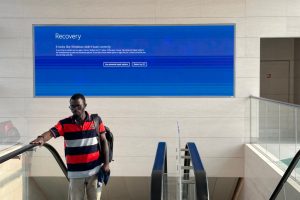
Pentagon briefing shows fury of B-2 bunker-busting bombs
The Pentagon detailed Thursday how bunker-busting bombs pierced Iranian nuclear sites with precision strikes by B-2s flown by “warriors” working in tandem with experts as U.S. Army soldiers manning Patriot missile defense systems in Qatar thwarted a retaliatory attack.
The step-by-step press conference with Defense Secretary Pete Hegseth and Joint Chiefs of Staff Chairman Gen. Dan Caine was held to push back at leaked reports on the damage estimates to Iran’s nuclear ambitions and to praise the skill and courage that went into stopping the 12 Day War between Israel and Iran.
“President Trump directed the most complex and secretive military operation in history. And it was a resounding success, resulting in a ceasefire agreement and the end of the 12 Day War,” Hegseth said, by “choose your word, obliterating, destroying Iran’s nuclear capabilities.”
Not only did the B-2 Stealth Bombers hit their targets — “by inches” — but also left Iranian airspace without harm. But that was only one side of the story, said Caine.
“Air defenders” at Al Udeid Air Base in Qatar, manning two Raytheon-made Patriot batteries with “roughly 44 American soldiers” who remained behind at the base, defeated an Iranian missile attack Monday.
“The oldest soldier was a 28-year-old captain. The youngest was a 21-year-old private who’d been in the military for less than two years,” Cain said. “So, let’s put ourselves out there for a second. Imagine you’re that young first lieutenant. You’re 25 or 26 years old, and you’ve been assigned as the tactical director inside the command and control element. You, at that age, are the sole person responsible to defend this base.”
Caine, the nation’s top military officer, then offered new details about the work that went into building the “bunker-buster” bombs and how the U.S. used them to burrow into the Iranian sites.
The bombs, called the GBU-57 A/B Massive Ordnance Penetrator, have their roots in a decades-old classified briefing “of what looked like a major construction project in the mountains of Iran,” Caine said.
That turned out to be the Fordo fuel enrichment plant, with construction believed to have started around 2006. It became operational in 2009, the same year Tehran publicly acknowledged its existence.
The classified briefing was shown in 2009 to a Defense Threat Reduction Agency officer, who with a colleague “lived and breathed” Fordo for the next 15 years, studying the geology, construction dig, the earth moved and “every piece of equipment going in and every piece of equipment going out,” Caine said.
What they concluded: The U.S. didn’t have a bomb that could destroy those sites. So the Pentagon got to work, Caine said.
“We had so many Ph.D.s working on the mock program — doing modeling and simulation — that we were quietly and in a secret way the biggest users of supercomputer hours within the United States of America,” he said.
The 30,000-pound bomb is comprised of steel, explosive and a fuse programmed to a specific detonation time. The longer the fuse, the deeper the weapon will penetrate before exploding.
Over the years, the military tested and retested it hundreds of times on mock facilities, Caine said. Crews fine-tuned the bombs to detonate in the mock enrichment rooms, delaying detonation until they had reached a position to send a pressure blast through open tunnels to destroy equipment underground.
Caine said the munitions were built, tested and loaded properly, guided to their intended targets and then exploded as designed.
“Iran’s nuclear facilities have been destroyed,” Hegseth said.
Pilots who dropped the MOPs on Iran called the blast “the brightest explosion” they ever saw, saying, “it literally looked like daylight,” Cain added.
The fury unleashed was displayed during the briefing that showed an MOP hitting a target in slow motion and cutting through the arched interior of a second ventilation shaft without detonating as it moved its way deeper through the test facility.
A B-2 bomber arrives at Whiteman Air Force Base Mo., Sunday. (AP Photo/David Smith)


